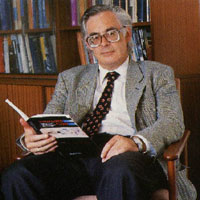Warwick Farewell - Professor Peter Carpenter
 It is with deep regret that the School has been informed of the death of Professor Peter Carpenter on Monday 21 April 2008 following a prolonged illness.
It is with deep regret that the School has been informed of the death of Professor Peter Carpenter on Monday 21 April 2008 following a prolonged illness.
Following his first degree from the University of London, Peter moved to the University of Cincinnati, Ohio, for his postgraduate studies before returning to Britain and the University of Manchester as a Research Assistant. In 1973 he was appointed Lecturer at the University of Exeter where he eventually became Head of Department before joining the University of Warwick in 1990 as Professor of Mechanical Engineering. Between 1997 and 2007 Peter was Head of the Civil & Mechanical Engineering Division of the School of Engineering.
During his career Peter Carpenter made many significant contributions to the field of fluid mechanics. His interests were diverse and he believed in pursuing quality in research above all else. A review of Peter’s output will demonstrate a number of strands and phases to his research career. In the early phase he worked on: supersonic free shear layers with large temperature differences (1971-1975); hydro elasticity and aero elasticity of panels (1982-1997); industrial heat & mass transfer (1984-1987); and the analysis of swirling flow in nozzles, ducts and jets (1975-1985) to which he made a key contribution.
A transition period followed as his interest and focus turned towards boundary-layer flow, which became his main area of research for a period extending over 25 years from the early 1980s. Despite its 100-year history, boundary-layer research remains one of the core areas of research in engineering fluid mechanics because it governs many of the important performance characteristics of objects exposed to a fluid flow. An understanding of boundary layers ultimately enables the development of techniques to reduce the drag forces and the power consumption of, for instance, aeroplanes, ships or other vehicles. Peter Carpenter was particularly interested in topics related to laminar-flow control and laminar-turbulent transition. Here he worked on laminar-flow control and turbulence suppression by means of compliant walls (1985-2001), instability and transition of rotating-disc boundary layers (1997-2006), and flow control exploiting micro-fabrication techniques (2001-2007). Peter Carpenter also worked on many other topics including industrial aerodynamics and aero acoustics (1995-1997), and biomechanics (1977-2003).
In biomechanics, Peter’s work on the swimming of dolphins was directly related to his interests in flow control and drag reduction. In 1936 James Gray, a zoologist, estimated that swimming dolphins required about seven times the power output of any other mammal in order to reach their high speeds. Since this seemed implausible there arose the question of whether dolphins are able to control the (boundary-layer) flow around their bodies in such a way that laminar-turbulent transition is postponed and, as a consequence, the drag forces reduced. Peter Carpenter often pointed out that Gray’s quantitative estimates were in fact inaccurate and with his collaborators went on to identify a means by which the dolphin’s cutaneous ridges might provide an explanation to this paradox. Indeed, Peter and his collaborators rank among the world’s leading scientists in the area of developing compliant coatings as a means of drag reduction. Their theoretical and experimental research of nearly 20 years has made major contributions to establishing the drag-reducing capabilities of compliant coatings.
Given his background in aeronautical and aerospace engineering it is appropriate that Peter also published research results on butterflies in gliding flight. However, he also worked on topics far removed from his aeronautical roots, for example Peter had a keen interest in the fluid-dynamical issues related to the medical disorder Syringomyelia, in which a cyst forms within the spinal cord. Peter’s extensive work in both computational and practical fluid dynamics brought him international recognition and in 2007/8 he gained a DSc from the University of Warwick.
Peter enjoyed walking, swimming and had a great love of jazz that started in his student days and never left him. Peter is survived by his wife Sally, three children and three grandchildren to whom we send our heartfelt wishes for their sad loss.
A Memorial Service will be held for Professor Peter Carpenter this term:
Date: Wednesday 14th May 2008
Time: 5.30 for 6.00 pm
Venue: Room R021, Ramphal Building, Library Road, University of Warwick
Duration: Approximately 1 hour
All are welcome. Drinks and nibbles will be available in the foyer of the Ramphal Building prior to the Memorial service. To assist with catering please let Margaret Clarke know if you will attend.
Contact: Margaret Clarke: Telephone (024) 7652 2014 or email: M.Clarke@warwick.ac.uk
